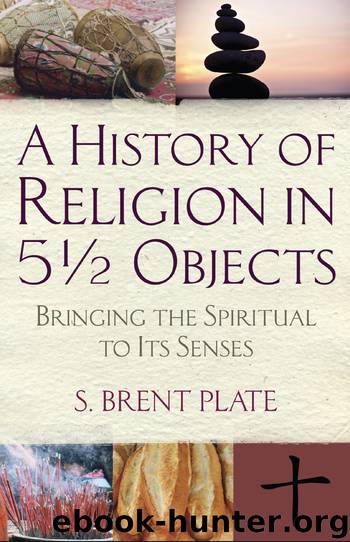A History of Religion in 5½ Objects by S. Brent Plate

Author:S. Brent Plate
Language: eng
Format: epub
Publisher: Beacon Press
If drums have sustained tradition, they have also resurrected it. The Ojibwe (Anishinaabe) people live in the lands now commonly known as Michigan, Wisconsin, Minnesota, and Ontario. Like all Native American groups, the westward expansion of white settlers in the nineteenth century forced them off their land, decimated their populations through war and disease, and had the effect of stripping them of religious and cultural traditions, including the demise of drum playing that had been so central to their life. Drums were longtime staple instruments of the indigenous people across the Americas, and the Ojibwe used a variety of them in their ceremonies, as they did rattles, singing, and dance, all of which operated as forms of prayer. Drums accompany a person through their life. They are there at birth rites, through the highs and lows of growth, and present at death: a drum was often placed in a grave alongside the deceased to accompany them on a four-day journey to the village of souls. Yet, as the Ojibwe adapted to new ways of life, and struggled to survive, many of the drum traditions were forgotten. By the beginning of the twentieth century, living on a few reservations and with few prospects, a startling thing occurred, the Drum Dance was born.22
Sometime in the last decades of the nineteenth century, a Dakota woman had a vision. She became known as Tailfeather Woman, and her visionary story is a creation story.* The story was told in response to political turmoil, which is often when stories of creation come about. In the midst of ongoing war with the US Cavalry (possibly including General Custer), who had massacred great numbers of Native Americans including the woman’s four sons, Tailfeather Woman escaped and hid under the lily pads of a lake, breathing through a reed. While in hiding the Great Spirit spoke to her and continued to speak over four days’ time, giving her songs and instructions for making and playing a great drum, saying that the pounding of the drum would bring healing and unity for her people. If the instructions are followed, the Great Spirit said, the soldiers would stop killing her people. She got up out of the water, told the survivors what she had heard, went about making and playing the drum, and singing and carrying out the proscribed ceremony. Sure enough, the white soldiers heard the sounds and stopped their killing and began to listen. Sometime after, peace agreements were made between the US government and the Indians. The drum and songs traveled from Tailfeather Woman’s Dakota land to other Native American people in the Great Lakes region such as the Ojibwe, and during the ceremonies some version of the woman’s story is told.
The drum is itself large and round (Ojibwe refer to it as “The Big Drum”), not unlike its predecessor used in the Grass Dance of various Northern Plains tribes (Omaha, Dakota-Sioux). The Ojibwe historically used small hand drums for healing ceremonies, warfare, and games, so the introduction of this large drum from the Tailfeather Woman’s vision was an adaptation.
Download
This site does not store any files on its server. We only index and link to content provided by other sites. Please contact the content providers to delete copyright contents if any and email us, we'll remove relevant links or contents immediately.
The Lost Art of Listening by Michael P. Nichols(7385)
Why I Am Not A Calvinist by Dr. Peter S. Ruckman(4086)
The Rosicrucians by Christopher McIntosh(3454)
Wicca: a guide for the solitary practitioner by Scott Cunningham(3117)
Signature in the Cell: DNA and the Evidence for Intelligent Design by Stephen C. Meyer(3050)
Real Sex by Lauren F. Winner(2949)
The Holy Spirit by Billy Graham(2877)
To Light a Sacred Flame by Silver RavenWolf(2754)
The End of Faith by Sam Harris(2675)
The Gnostic Gospels by Pagels Elaine(2459)
Waking Up by Sam Harris(2379)
Nine Parts of Desire by Geraldine Brooks(2313)
Jesus by Paul Johnson(2294)
Devil, The by Almond Philip C(2266)
The God delusion by Richard Dawkins(2251)
Heavens on Earth by Michael Shermer(2223)
Kundalini by Gopi Krishna(2127)
Chosen by God by R. C. Sproul(2113)
The Nature of Consciousness by Rupert Spira(2031)
